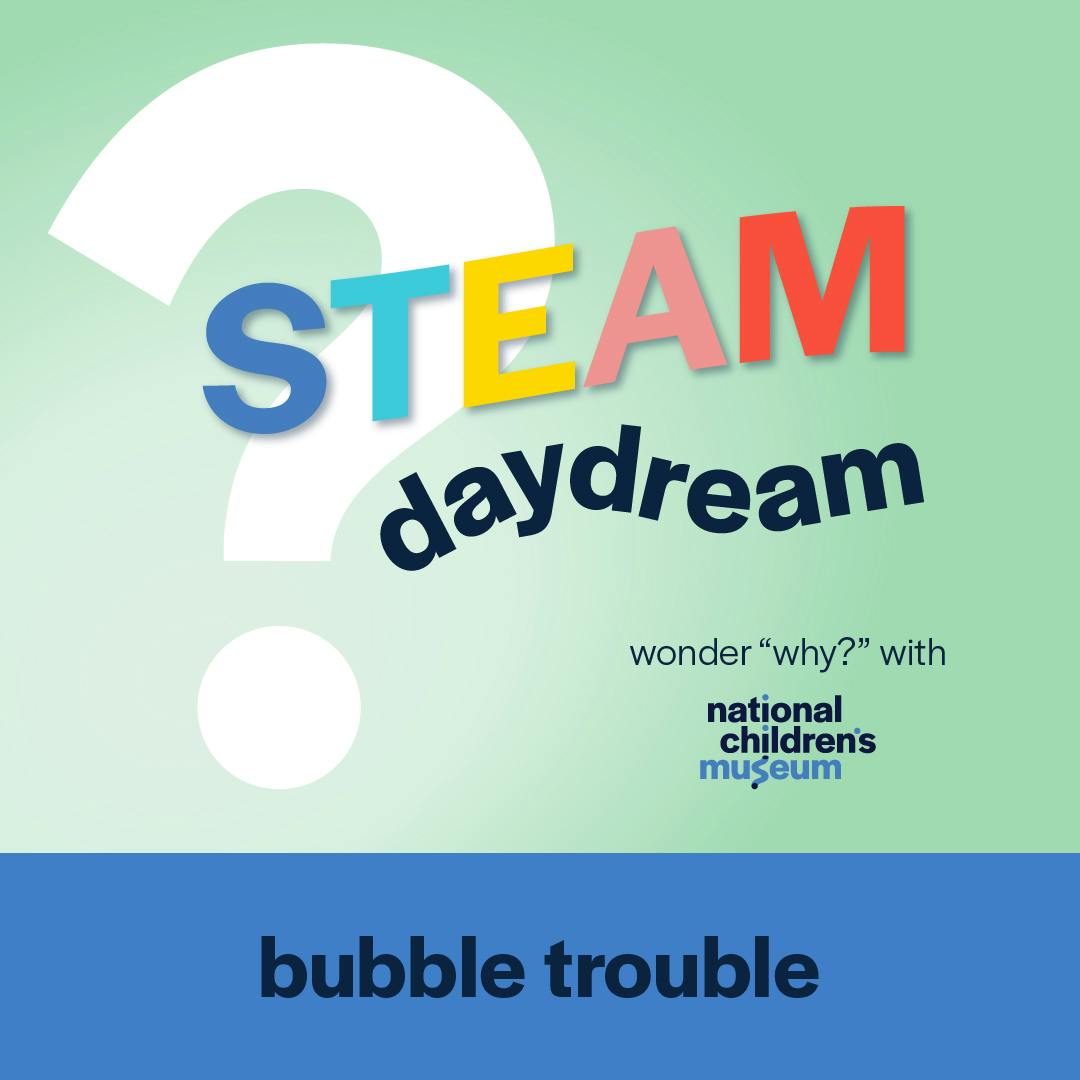bubble trouble
When Janay challenges Andre and Aubrey to a bubble blowing battle, they think outside of the box for a way to blow away the judges, including 11-year-old Kid Investigator Kaedence. They decide the best way to upstage Janay is with a bubble in the shape of a cube. When things don’t go according to plan, Janay wins fair and…circle? Will they be able to square why bubbles are always round?
 meet our kid investigator Kaedence R. (she/her) from Orlando, Florida 11-years-old favorite school subject: science |
 meet our expert Dr. Lan-Hsuan Huang (she/her) Professor of Mathematics at University of Connecticut fun fact: "Can you make bubbles on the Moon? No! If you were blowing bubbles on the Moon (or in the vacuum of space), there would be no air to push back on the outside of the bubble so it would pop instantly.” |
- surface tension: a force which causes a layer of liquid to behave like an elastic sheet or skin
- geometry: a kind of math that deals with shapes and figures
- elasticity: a property that describes an object’s ability to return to its original shape after being subjected to a force, like being stretched
- surface area: a measurement of all the space that the surface of a 3D object takes up
- sphere: a 3D shape that is perfectly round, like a ball
- volume: the amount of liquid, solid, or gas that can fit inside a 3D shape
- 5-PS1-4 Matter and Its Interactions: Conduct an investigation to determine whether the mixing of two or more substances results in new substances.
- 5-PS1-1 Matter and Its Interactions: Develop a model to describe that matter is made of particles too small to be seen.
- 5-PS1-3 Matter and Its Interactions: Make observations and measurements to identify materials based on their properties.
[MUSIC]
A.J.: What are they doing? They must be working on something big in the studio today.
ANDRE: Oh hey! It’s A.J.!
A.J.: What are you working on?
ANDRE: Remember at the beginning of summer when we designed that spaceship?
AUBREY: You know, the one we were going to use to send Newton to the moon!
[BARK/MEOW]
AUBREY: Well, we dug up the blueprints, and with some slight modifications, we made this.
ANDRE: The double bubble blower 3000!
A.J.: What’s it for?
ANDRE: Maggie the Mailperson dropped by this morning with this note from our friend Janay. She’s challenging us to a bubble blowing battle at National Children’s Museum.
A.J.: Today? Didn’t you see the STEAM mystery investigation on the calendar? Our Kid Investigator is already on her way.
ANDRE: Oh, perfect! She can be the other judge—tell her to meet us at the Museum in exactly 15 minutes!
A.J.: Let me guess, you already signed me up to be a judge…
AUBREY: We didn’t think you’d mind!
A.J.: Well, if I have to be a judge, then you have to play by my rules, which means no fancy shmancy gadgets like the double bubble blower 3000. If you want to win the bubble blowing contest, you better blow the bubbles yourself… fair and square.
ANDRE: But A.J.!
A.J.: Ah! No buts! Just bubbles. Time to think of a back-up plan—and no cutting corners. I’ll see you over at the Museum.
ANDRE: What are we going to do now?!
AUBREY: Hmm… No cutting corners… Fair and square… Ah-ha! I have an idea!
[MUSIC]
A.J.: You’re listening to Season 2 of STEAM Daydream with National Children’s Museum, where we solve the world’s many STEAM mysteries one episode at a time: we’ll observe, we’ll ask questions, we’ll investigate, we’ll research, and then we’ll connect the dots! At least that’s what we’re supposed to do. But today we’re having a bubble blowing battle, which for the record was absolutely not my idea!
AUBREY: A.J., come on!
A.J.: Ok. Welcome, everyone, to the bubble blowing battle at National Children’s Museum! Today, Aubrey and Andre will compete against Janay to see who can blow the most unbelie-bubble bubble! My name is A.J., and I’ll be one of the judges of today’s competition. To my left is Kaedence, our 11-year-old Kid Investigator and chief bubble examiner from Orlando, Florida.
KAEDENCE: Hello, everyone, happy to be here. Bubbles are the best!
A.J.: And to my right, behind this very dramatic red velvet curtain, is our mystery judge and bubble expert! Now, before we get this bubble party started, let’s hear what a few of the curious kids in today’s audience have to say about bubbles. Contestants, listen closely for some tips and inspiration!
[MUSIC]
CHILD 1: Bubbles are the shape of circles or spheres.
CHILD 2: Bubbles are shiny.
CHILD 3: Bubbles look like soap but even better.
CHILD 4: Bubbles look like water floating in the sky.
CHILD 5: Bubbles look like shiny glossy spheres.
CHILD 6: I think bubbles look like a circle of air. Like holding a rainbow.
CHILD 7: I think bubbles are fun and cool to play with, especially when I get to pop them!
CHILD 8: Inside of a bubble I believe is air.
CHILD 9: I think you can pop them, and they’re awesome.
CHILD 10: Bubbles pop because bubbles are kinda like soap, water, and chemicals. Soap, water and chemicals aren’t really strong.
CHILD 11: I think bubbles pop because they’re really thin.
CHILD 12: I think they float because they’re so light, but I don’t actually exactly know why.
A.J.: Wow, sounds like we have some real bubble lovers in attendance today. Will Janay or Aubrey and Andre be able to impress them with their bubble blowing skills? It’s time to find out!
KAEDENCE: The rules are simple. The bubble must float in the air and you can’t use any motorized gadgets.
A.J.: Each judge will rate your bubble on a scale of 1 to 10 based on its size, how long it lasts, and overall WOW factor.
KAEDENCE: Janay, you’re up first. What’s your strategy today?
JANAY: My strategy is, the bigger the bubble the better!
KAEDENCE: And what will you be using?
JANAY: This hula hoop! First, I’ll dip it into the tub of super special bubble solution. Once the hoop is coated, I carefully lift the hoop, spin in a circle, pushing air into the bubble, and…
A.J.: Wow! I’ve never seen a bubble that big before! And on the first try! I give it a 9 out of 10.
KAEDENCE: And did you see how shiny it was? Definitely a 9 out of 10.
A.J.: Mystery judge, what are you giving Janay’s bubble?
A.J.: Another 9!
KAEDENCE: Congratulations, Janay! That means you got 27 points out of a possible 30.
A.J.: Aubrey, Andre, that’s going to be hard to beat. What’s your strategy?
AUBREY: Actually, our strategy was inspired by you, A.J. Remember when you said Andre and I shouldn’t cut corners? How we had to win fair and square?
ANDRE: Well, we’re going to do just that! We’re going to be blowing a bubble in the shape of a cube using this square bubble wand!
AUBREY: We made it ourselves by connecting four fuzzy pipe cleaners in the shape of a square, which we attached to the handle of a fly swatter. See!
KAEDENCE: Wow, innovative!
ANDRE: Ok, everyone, can we get a countdown?
A.J./CHILDREN: 3, 2, 1!
ANDRE: Uh-oh.
AUBREY: That didn’t look like a cube bubble, did it?
ANDRE: Hold on, that was just a warm-up! Here comes the real deal!
KAEDENCE: I thought you said you were blowing your bubble in the shape of a cube?
A.J.: Yeah, that bubble looked round to me.
AUBREY: I don’t understand. When you use a circle bubble wand, you get a bubble in the shape of a sphere—like a circle but in 3D.
ANDRE: So if we use a square bubble wand, shouldn’t we get a bubble in the shape of a cube—you know, the 3D version of a square?
A.J.: Hm... It looks like we’ll be investigating a STEAM mystery today after all. Why are bubbles round?
[MUSIC]
KAEDENCE: Well, let’s start with what we know.
AUBREY:, Andre, why don’t you take us through the bubble blowing process step-by-step with a regular, round bubble wand so we can observe and take notes.
AUBREY: Sure! First, we dip the wand into the tub of bubble solution and swirl it around to make sure it’s soaked.
ANDRE: When we lift it up, we can see a thin film of the solution stretched across the opening of the bubble wand.
AUBREY: We slowly blow air into the opening of the wand, and the thin film of bubble solution starts to wrap around the air. As we blow more air into the bubble, the film starts to close and eventually seals shut and separates from the wand.
ANDRE: And then, the little pocket of air surrounded by the film floats away as a bubble!
KAEDENCE: Sounds simple enough. Janay, earlier you said the bubble solution was super special. Can you tell us what’s so special about it?
JANAY: Well, I make it following my grandma’s recipe. It’s a mixture of soap and water.
KAEDENCE: Interesting. I wonder what would happen if we tried to blow a bubble with plain water. Would it work?
JANAY: Let’s try! I have some plain water right here. Let me dip the regular bubble wand and lift it up… Hm, it looks like the water doesn’t stretch across the opening of the wand like the bubble solution does. Nothing. Bubbles definitely don’t work with plain water.
KAEDENCE: So, how does adding soap to water change the water’s ability to form a bubble?
ANDRE: Hm, this sounds familiar. I’ve read about this somewhere…oh, I remember! The Museum’s Bubble Zone!
AUBREY: Oh yeah, the part of the Museum where you surround yourself with a giant bubble. It’s right over here!
ANDRE: What does the sign next to it say?
AUBREY: It says, “A scientific phenomenon known as surface tension is what allows the bubble to form. On its own, water doesn’t have enough surface tension to make a bubble, so by adding soap to our bubble solution we increase the surface tension of the water, and allow the bubble to stretch even further. Stretch the bubble too much and it pops because there is no longer enough surface tension!”
ANDRE: Of course! I’ve heard of surface tension before. It’s a force that causes a layer of liquid to act like an elastic sheet. If you’ve ever seen bugs walk across the surface of water before, you’ve seen surface tension in action!
AUBREY: Oh. So bubbles pop when we touch them because we break the surface tension of the bubble solution!
KAEDENCE: That’s interesting, but it doesn’t answer our big question of why bubbles are always round.
DR. LAN-HSUAN: Actually, it is part of the answer.
ANDRE: Was that you, Mystery Judge?
DR. LAN-HSUAN: Well, I guess I’m not a mystery judge anymore. I’m Dr. Lan-Hsuan Huang.
AUBREY: And what makes you a bubble expert?
DR. LAN-HSUAN: I research geometry. Geometry is one of the oldest branches of mathematics that studies shapes. So we work to understand how and why the shape forms.
KAEDENCE: So how does surface tension affect the shape of a bubble?
DR. LAN-HSUAN: This is a very good question. Surface tension is the force that causes the liquid surface to hold it together. Although the liquid surface looks very smooth, it's actually formed by billions and trillions of much smaller particles called molecules. Those molecules are pulled tightly in all directions. Imagine that they are holding hands together and trying to pull one another closer. As a result, a liquid surface becomes like a sheet of fabric or a layer of water acting like elastic. A bubble is a liquid surface that forms around surface tension. When the soap film is still attached to the bubble wand. It can have all kinds of crazy shapes depending on the shape of wand and the way you blow air into it. But as soon as the soap film separates from the wand, it instantly becomes round because those tiny particles tighten the shape of the bubble to make its surface area as small as possible. The bubble becomes round because the sphere is the shape that has the smallest surface area to enclose the air.
ANDRE: So, you’re telling me that no matter what shape my bubble wand is, the bubble I blow will always be round?
DR. LAN-HSUAN: Exactly.
ANDRE: Even if the wand was in the shape of a… heart?
DR. LAN-HSUAN: The bubble would still be round.
AUBREY: What if the wand was in the shape of a star?
DR. LAN-HSUAN: Still round.
ANDRE: Oh, oh! What if the bubble wand was in the shape of a walrus?
KAEDENCE: I’m going to guess the bubble would still be round, Andre.
DR. LAN-HSUAN: Right. Think about it this way. Area is a measurement of how big a service is. Think of a piece of drawing paper. I want to fully color it with crayons. I need maybe one or two crayons to do that. But if I would like to color the entire floor of a basketball court, I would need many more crayons because it's a much larger surface area. Surface area is a precise measurement that tells us the size difference of shapes. To increase the area requires larger energy because that means more molecules are in a restless situation. The least area means that it requires the least energy to hold the shape.
KAEDENCE: I think we have the information we need to solve the mystery of why bubbles are round. Thanks for your help, Mystery Judge!
DR. LAN-HSUAN: Oh, there was no problem at all. I love talking about bubbles.
KAEDENCE: Andre, Aubrey, let’s connect the dots.
[MUSIC]
AUBREY: It all starts with 2D and 3D shapes! The “D” in 2D and 3D stands for “dimensional,” and the number tells us how many dimensions the shape has. 3D shapes, like spheres and cubes, stick out because they have 3 dimensions: height, length, and width. We can figure out many things using these dimensions, like surface area and volume. Surface area is the measurement of all the space the surface of a 3D shape takes up. Like when you wrap a present in a gift box, the surface area would be the amount of wrapping paper you use to cover the outside of the box. Volume is the amount of liquid, solid, or gas that can fit inside a 3D shape, like when you fill up a water bottle.
ANDRE: Of all 3D shapes, spheres have the smallest possible surface area that contains the most volume.
AUBREY: Imagine you have two empty snowglobes in front of you. One snowglobe is in the shape of a sphere. The other one is in the shape of a cube. They each have the same surface area, which means it would take the exact same amount of wrapping paper to wrap them both.
ANDRE: Now, if we started pouring water into both snow globes at the same time and speed, the cube snowglobe would fill up faster. The sphere snowglobe would still have room for more water because it has a larger volume.
AUBREY: Ok, back to bubbles! Like Dr. Lan-Hsuan explained, the surface tension of the soapy film that makes up a bubble’s surface forces the bubble into the shape with the smallest possible surface area that can hold the most air, which is a sphere!
ANDRE: So no matter what shape of bubble wand you start with, the surface tension of the film will always contract like elastic into a round, sphere-like shape.
AUBREY: And that’s why bubbles are always round!
A.J.: A-ha, so that’s why I’ve never seen a bubble in the shape of a cube!
JANAY: So that means I win the bubble blowing battle, right?!
A.J.: I think solving this STEAM mystery makes us all winners! But yeah, Janay, you won!
[MUSIC]
A.J.: Well, there you have it, Dreamers! Next time you’re at National Children’s Museum, be sure to check out the Bubble Zone that helped the STEAM Daydream investigative team solve today’s mystery. Click the link in the show notes to check out our guided activity video about bubbles, which includes a recipe for the perfect at-home bubble solution. That’s all for this episode, Dreamers! Meet us back here to help us make sense-ity of density. In the meantime, if you enjoyed today’s show, please leave a review to help other curious kids discover our podcast. Be sure to subscribe wherever you’re listening so you don’t miss our next adventure. You can find more STEAM programs and resources on our website at www.nationalchildrensmuseum.org. Season 2 of STEAM Daydream with National Children’s Museum is generously sponsored by GEICO. It’s narrated by me, A.J. Calbert, produced by Paige Childs, with sound design and engineering by Maddie Zampanti of Conceptual Podcasting. Take Care Dreamers!

